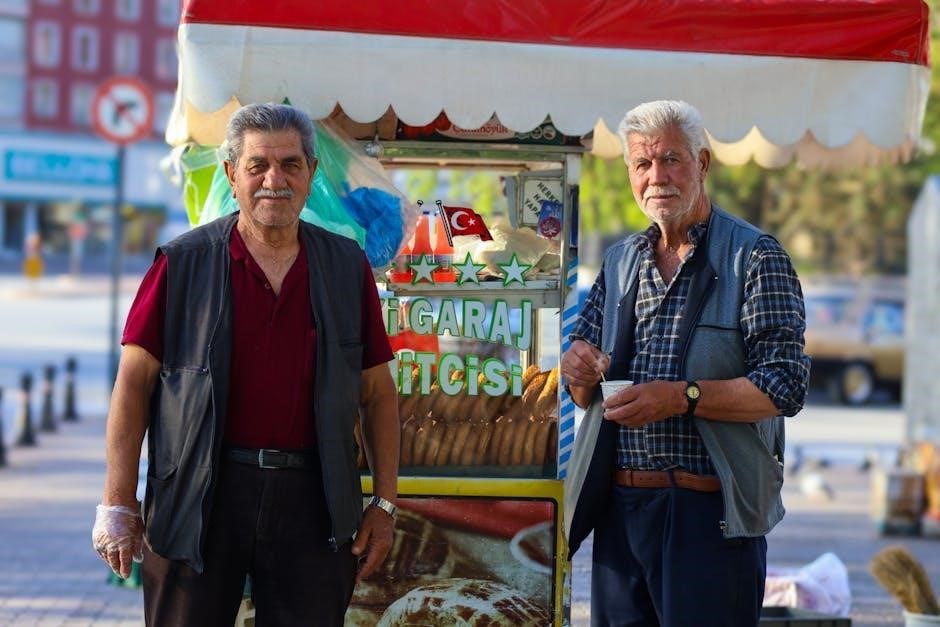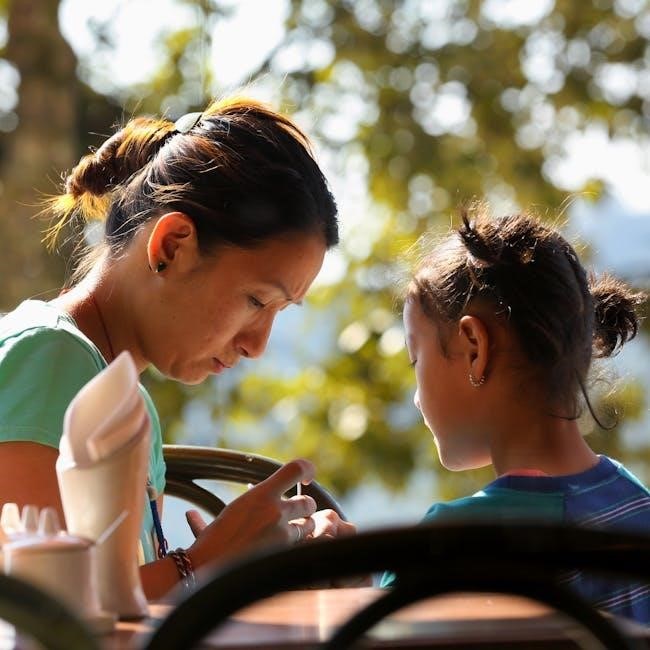The Midwest is known for its warm, down-to-earth communication style, rooted in strong cultural values like friendliness, humility, and community ties. Conversations often reflect a straightforward yet polite demeanor.

1.1 Cultural Values and Their Impact on Communication
The Midwest’s cultural values, such as humility, friendliness, and a strong sense of community, deeply influence communication styles. People often prioritize politeness and avoid boastfulness, reflecting a modest approach to interactions. Phrases like “Oh, it was nothing” or “You’re too kind” highlight this humility. Friendliness is evident in open and welcoming conversations, where strangers are often treated like acquaintances. The emphasis on community fosters a collaborative tone, with discussions frequently revolving around shared experiences or local pride. These values create a warm, approachable atmosphere, making Midwestern communication feel genuine and down-to-earth. Active listening is also highly valued, showcasing respect for others’ opinions. Overall, Midwesterners’ cultural values shape a communication style that is both gracious and relatable, making it a hallmark of the region’s social interactions.
1.2 Regional Dialects and Vocabulary
The Midwest is home to a distinct set of dialects and vocabulary that reflect its cultural identity. Common phrases like “hot dish” (a casserole) or “pop” (instead of “soda”) are staples in everyday conversation. Regional variations exist, with terms like “bubbler” (water fountain) in Wisconsin and “up north” referring to vacation areas. The Upper Midwest often features Scandinavian influences, while other areas may have German or Dutch traces. Pronunciation tends to be neutral, with a flat vowel sound in words like “about” or “house.” Midwesterners frequently use phrases like “Oh, for sure” or “You betcha,” which emphasize agreement and friendliness. These dialects and expressions create a sense of regional pride and camaraderie, making conversations feel uniquely Midwestern. The vocabulary often mirrors the region’s down-to-earth lifestyle, with practicality and simplicity at its core.
Common Phrases and Expressions in Midwestern Conversation
Midwesterners often use unique, colorful phrases that reflect their culture. Expressions like “I didn’t really care for it” and “Oh, for sure” add warmth and humor to daily interactions, showcasing regional charm.
2.1 Politeness and Courtesy
Politeness is a cornerstone of Midwestern conversation, reflecting the region’s down-to-earth, warm, and humble nature. Phrases like “please,” “thank you,” and “excuse me” are used frequently, often paired with a smile. Midwesterners tend to avoid bragging or complaining excessively, opting instead for modest expressions. For example, they might say, “I’m not sure if this is any good, but I brought a dish to share,” showcasing humility. Apologies are common, even in situations where one isn’t at fault, such as saying, “Sorry about the weather” or “Excuse me, I think you dropped that.” This politeness extends to offering help or hospitality, like asking, “Can I get you something to drink?” or “Would you like to stay for dinner?” Such courteous gestures create a welcoming and inclusive atmosphere, making conversations feel more like interactions among friends than strangers.
2.2 Humor and Sarcasm
Midwesterners often use humor and sarcasm to connect and lighten the mood, but their delivery tends to be subtle and self-deprecating. Sarcasm is common, though it’s often wrapped in a polite tone to avoid sounding harsh. For example, someone might say, “Oh, great, another snowstorm—just what we needed!” in response to bad weather; Humor frequently revolves around everyday life, like farming, weather, or local sports teams. Jokes are often understated, and Midwesterners may use deadpan delivery, making it easy for outsiders to miss the humor. Self-deprecating comments, like “I’m not much of a cook, but I made this anyway,” are also common. While their humor can be layered, it’s rarely mean-spirited, reflecting the region’s emphasis on kindness and community. This approach to humor helps build rapport and creates a relaxed, approachable atmosphere in conversations.

Communication Styles in the Midwest
Midwestern communication is straightforward yet polite, balancing directness with courtesy to foster trust and approachability in conversations.

3.1 Directness vs. Indirectness
Midwesterners often strike a balance between directness and indirectness in communication. They value straightforwardness, preferring clear and concise expressions of thoughts and opinions. For instance, saying “I didn’t really care for it” instead of “I hated it” reflects their tendency to soften directness with politeness. However, indirectness can emerge in situations where conflict or offense might arise, such as avoiding blunt criticism to maintain harmony. This blend of styles fosters trust and approachability, making conversations feel both honest and respectful. The Midwest’s communication approach emphasizes clarity while preserving a courteous tone, ensuring that interactions remain constructive and amicable.
3.2 Active Listening and Responses
Active listening is a cornerstone of Midwestern communication, reflecting the region’s emphasis on respect and community. People often nod, maintain eye contact, and use verbal cues like “uh-huh” or “I see” to show engagement. Responses are typically thoughtful and concise, avoiding overly elaborate expressions. Midwesterners tend to avoid interrupting others, valuing the speaker’s perspective and allowing them to finish their thoughts. This approach fosters a sense of harmony and mutual respect. Responses often include phrases like “That’s interesting” or “I appreciate that,” which acknowledge the speaker without dominating the conversation. The focus is on balancing contributions rather than competing for attention. This style of interaction reinforces the Midwestern values of humility and collaboration, ensuring conversations remain productive and respectful.

Social Norms and Taboos in Conversation
Midwesterners value respect and avoid confrontation, often steering clear of sensitive topics like politics or personal finances. Open discussions about religion or social issues are approached with caution and tact.
4.1 Greetings and Farewells
In Midwestern culture, greetings and farewells are warm and polite, reflecting the region’s emphasis on hospitality. Common greetings include “How are you?” or “How’s it going?” often paired with a smile. Farewells like “See you later” or “Take care” are frequent. Informal expressions such as “Hey, how’s it going?” or “Bye, see ya!” are also prevalent. Midwesterners often use phrases like “It was great seeing you” or “Nice talking to you” when parting ways. These exchanges are typically straightforward and sincere, avoiding overly elaborate language. The focus is on making others feel welcome and valued, showcasing the Midwest’s reputation for friendliness and approachability. These interactions are integral to building trust and fostering positive relationships in both casual and formal settings.
4.2 Discussing Sensitive Topics
Midwesterners often approach sensitive topics with diplomacy and tact, reflecting their cultural emphasis on harmony and politeness. Conversations about controversial subjects, such as politics or religion, may be avoided in casual settings to prevent discomfort. When such topics arise, they are typically addressed indirectly, with a focus on listening rather than confrontational debating. Phrases like “I think…” or “In my experience…” are commonly used to soften opinions. Midwesterners may also express reluctance to discuss sensitive issues openly, preferring to maintain a neutral stance. For instance, they might say, “I don’t like to get into that” or “I’m not sure I’m the best person to talk about that.” This approach highlights their preference for maintaining goodwill and avoiding conflict, even if it means sidestepping difficult conversations. By doing so, they uphold their reputation for being respectful and considerate communicators.
Practical Tips for Engaging in Midwestern Conversation
Engage by actively listening, showing genuine interest, and asking open-ended questions. Share relatable experiences and maintain humility. Avoid boastfulness, as Midwesterners value modesty and authenticity in dialogue.
5.1 Starting and Maintaining Conversations
Starting a conversation in the Midwest often begins with a friendly greeting or a comment about shared experiences, like the weather or local events. Authenticity is key; avoid overly formal language and instead opt for a casual, approachable tone. Show genuine interest by asking open-ended questions and actively listening to the response. Midwesterners appreciate humility, so steer clear of boastful statements. Instead, share relatable stories or experiences that foster connection. Maintaining the conversation involves balancing talk and listen, ensuring it feels natural and collaborative. Compliments are well-received but should be sincere. Avoid controversial topics initially, focusing instead on neutral subjects like food, sports, or family. Patience and attentiveness go a long way in building rapport. Remember, the goal is to create a sense of comfort and mutual understanding, reflecting the region’s values of warmth and inclusivity.
5.2 Understanding Nonverbal Cues
Nonverbal cues play a significant role in Midwestern communication, where subtlety and restraint are often valued. Eye contact is important but should be respectful and not overly intense, as Midwesterners tend to avoid aggressive displays of emotion. Facial expressions are generally mild, reflecting a calm and composed demeanor. Body language is open but not overly expansive, with a preference for comfortable personal space. Hand gestures are minimal, as Midwesterners often prioritize simplicity and humility in their interactions. Smiling is common and serves as a sign of friendliness and approachability. Understanding these cues can help you navigate conversations more smoothly, as they often convey emotions or intentions that may not be explicitly stated. Paying attention to these subtle signals can foster trust and rapport, aligning with the region’s emphasis on politeness and reserve.